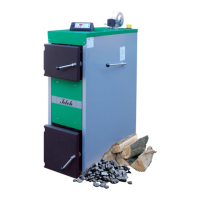9. Leaky chimney cleanout door.
10. Foreign objects in the chimney duct, e.g. a piece of a broken brick.
11. Other devices connected to the chimney duct, apart from the central heating boiler itself,
such as kitchen hearths, fireplaces, smokehouses, etc.
12. Dirty chimney duct. You cannot identify it visually, since more dirt is deposited in the
middle part of the chimney.
13. Internal chimney duct cross-section changes and offsets.
14. Too deeply inserted breeching.
15. A bend in the breeching (elbows, etc.) on the section connecting the boiler with the
chimney.
16. Too long breeching, i.e. the section of the flue gas duct connecting the heating boiler with
a chimney, which is additionally not insulated.
17. Wrong (too small) breeching cross-section – should be bigger than the cross-section of
the flue outlet fitting.
18. Mesh inserted on a chimney duct outlet.
19. Concrete caps finishing the outlet and causing lateral flue gas outlet.
20. Cold chimney – located outside a building (the chimney must be warm!!!)
21. Connecting sewage air vents into the chimney duct.
22. Lack of appropriate boiler room ventilation, especially air supply ventilation.
23. Use of mechanical exhaust ventilation (the use of which is unacceptable because it can
lead to flue gas being sucked into the boiler room).
Unfortunately, the majority of these failures can be found only by a master chimney
sweep.
We remind you that the chimney duct should be cleaned every 6 weeks!
An incorrectly working chimney cannot be the grounds for boiler warranty claim.
Typical boiler operation disorders
1. The causes of impossibility for obtaining full boiler efficiency can be the following:
a. too low chimney draft – chimney duct, breeching or boiler cleanout leaks
should be tightened, check chimney cleanout door tightness (a very frequent
cause),
b. bad fuel quality – inferior fuel should be burned during warmer periods, when
lower boiler efficiency is required,
c. dirt deposited in flue ducts – clean boiler ducts, breeching and chimney.
Check if a non-combustible object covers the inlet to the ceramic burner.
d. accumulation of a large amount of ash cinder on the grate causing air flow
constriction - this should be removed.
e. lack of air inflow to the boiler room -
ensure air inflow through a window or a ventilation duct.
f. too rapid or too slow burning process – incorrectly adjusted supply air – set
the fan and secondary air valves correctly.
g. wet walls of the fuel loading chamber – this phenomenon occurs particularly
intensely when the fuel is wet, at the same time reducing boiler output.
2. Very rapid water temperature growth on the boiler outlet at inadequate water
temperature on the inlet to radiators.
Cause: broken or limited water circulation in the heating system (reduced water level in the
expansion tank).
The system should be refilled with water. Check for water level reduction cause (see if there
are any leaks in the system).
An incorrectly completed (e.g. air-locked) system.
Incorrectly installed circulation pomp – short circulation.

